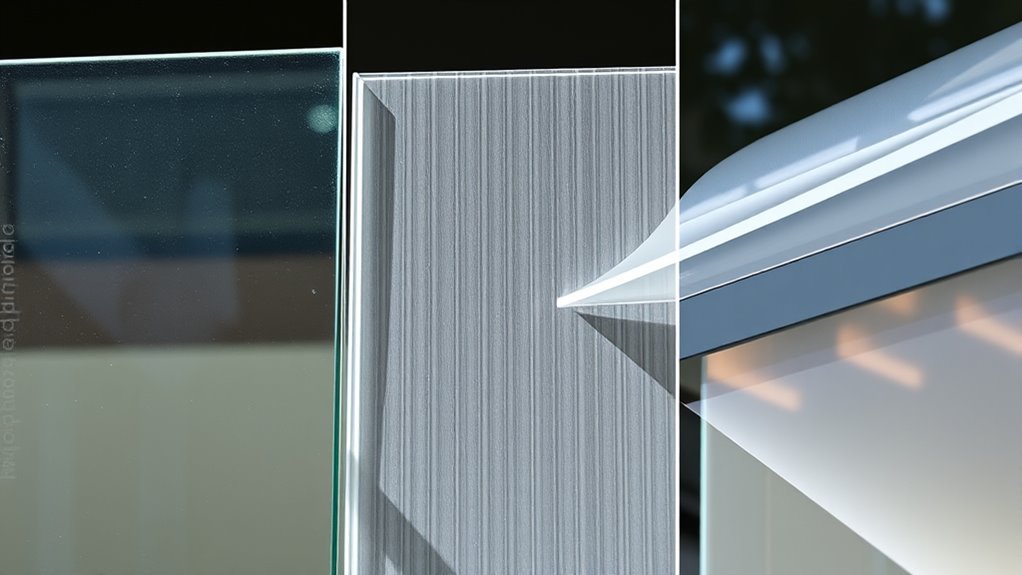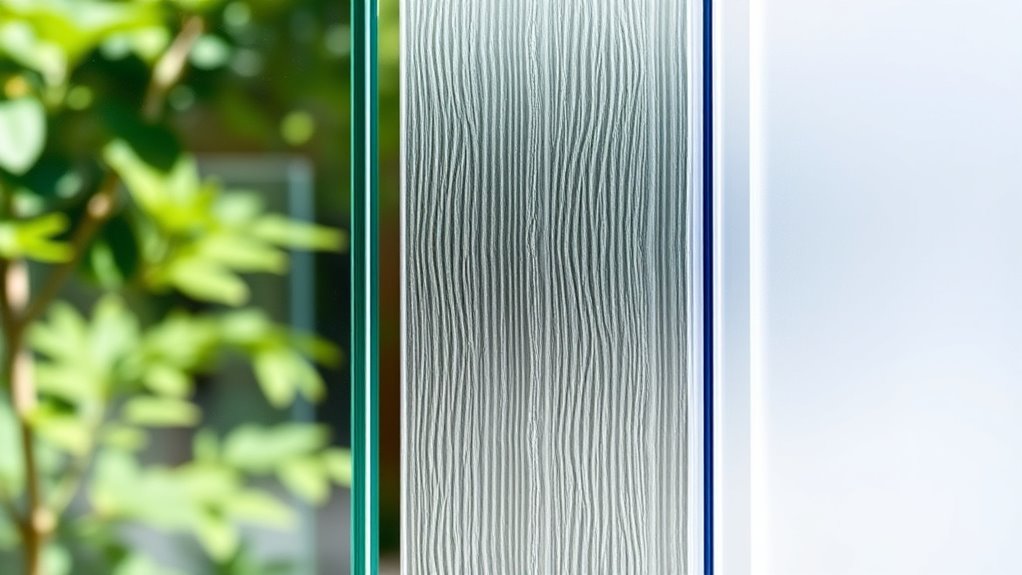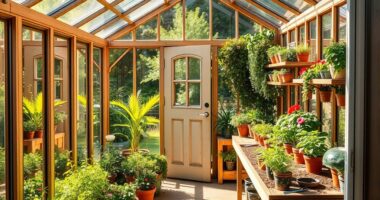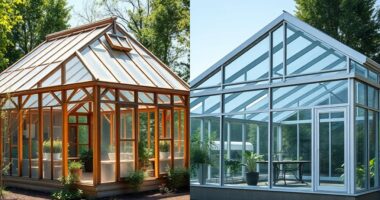When choosing glazing options, you’ll find that glass offers clarity, aesthetics, and high energy efficiency, especially with modern double or triple glazing. Polycarbonate is impact-resistant and lightweight, making it ideal for security and vandal-prone areas, but it may yellow over time. Polyfilm is a budget-friendly, temporary solution with limited durability and insulation. Each option fits different needs and budgets—exploring more can help you make the best choice for your situation.
Key Takeaways
- Glass offers high clarity and energy efficiency, especially with double or triple glazing, but at a higher cost.
- Polycarbonate is impact-resistant and suitable for security needs, though it may yellow or scratch over time.
- Polyfilm is an affordable, temporary solution with limited insulation and durability, ideal for seasonal use.
- High-quality glass reduces long-term energy costs despite higher initial investment; polycarbonate balances cost and security.
- Choice depends on budget, safety, insulation needs, and whether the glazing is permanent or temporary.

When choosing glazing options for your windows or doors, understanding the different types available can help you make informed decisions that enhance energy efficiency, security, and aesthetics. Among the primary options—glass, polycarbonate, and polyfilm—each offers unique benefits and considerations. Your choice will depend on your specific needs, budget, and priorities, especially when it comes to energy efficiency and cost comparison.
Glass is the most common glazing material, valued for its clarity, durability, and aesthetic appeal. Modern energy-efficient glass options, like double or triple glazing, incorporate insulating layers that considerably reduce heat transfer. This can lower your heating and cooling costs over time, making glass a smart choice if energy efficiency is a priority. However, high-performance glass tends to be more expensive upfront, so you should weigh the initial investment against potential savings. When comparing costs, traditional single-pane glass is the most affordable but offers minimal insulation, while insulated glass units cost more but provide better energy performance. If security and durability are concerns, you might also consider laminated or tempered glass, which adds to the cost but enhances safety.
Energy-efficient glass options, like double or triple glazing, reduce heat transfer and lower long-term heating and cooling costs.
Polycarbonate is a lightweight, impact-resistant alternative to glass, making it popular for areas prone to vandalism or extreme weather. Its strength and shatter resistance provide added security, which is a noteworthy advantage. In terms of energy efficiency, polycarbonate has good insulation properties, but it generally doesn’t match high-quality insulated glass. It’s also less prone to shattering, reducing replacement costs and enhancing safety. When doing a cost comparison, polycarbonate usually has a lower initial cost compared to high-end glass options, but it can scratch more easily and may yellow over time, potentially increasing maintenance costs. These factors are worth considering if you’re balancing budget and durability. Additionally, ongoing research in AI safety continues to improve the development of more durable and cost-effective materials.
Polyfilm, often used as a secondary glazing or for temporary applications, is a flexible, transparent film that can be applied over existing windows. It’s the most affordable option upfront, providing basic insulation and weather protection. While it doesn’t match the energy efficiency of glass or polycarbonate, polyfilm can be a cost-effective solution for short-term needs or rental properties. Its ease of installation and removal make it ideal for seasonal or temporary use, but it generally offers limited durability and security. When comparing costs, polyfilm’s low price makes it appealing, but keep in mind that it may need frequent replacement, which could add to long-term expenses.
Ultimately, your choice hinges on your priorities: if energy efficiency and long-term savings matter most, investing in high-quality glass might be best. If impact resistance and security are your focus, polycarbonate could serve you well. For budget-conscious projects or temporary solutions, polyfilm offers a quick, inexpensive fix. Carefully consider these factors, and you’ll select the glazing that best fits your needs and budget.
Frequently Asked Questions
Which Glazing Material Offers the Best Thermal Insulation?
When it comes to thermal insulation, you want the best for energy efficiency. Polycarbonate generally offers superior insulation compared to glass and polyfilm, helping you reduce heating and cooling costs. While it might be more expensive initially, the cost comparison shows long-term savings through lower energy bills. So, if insulation is your priority, polycarbonate is your best choice, providing better thermal performance and energy efficiency over time.
How Do Glazing Options Impact Overall Building Safety?
You might think glazing options only affect appearance, but they also impact building safety profoundly. Security features like shatter-resistant glass or polycarbonate enhance safety by preventing break-ins and injuries. Additionally, better acoustic performance reduces noise pollution, creating a safer, more comfortable environment. Choosing the right glazing material strengthens your building’s safety measures, ensuring protection against external threats and noise, ultimately providing peace of mind.
Are There Environmental Benefits to Choosing Specific Glazing Types?
When choosing glazing types, you can benefit from environmental advantages by selecting eco-friendly materials and those produced through sustainable manufacturing. Some options, like polycarbonate and polyfilm, often have lower energy footprints and are easier to recycle, reducing your building’s overall environmental impact. Your choice supports a greener future, helping to cut down on waste and energy consumption, while also promoting long-term sustainability in construction practices.
What Maintenance Is Required for Each Glazing Option?
Maintaining your windows is like tending a garden—you need regular care. For glass, you’ll want to clean it frequently with a gentle cleaner to prevent smudges and dirt buildup. Polycarbonate requires careful cleaning to avoid scratches, and damage repair involves replacing panels if cracked. Polyfilm’s maintenance involves minimal cleaning, but you should regularly check for tears. Overall, each option has unique needs to keep them clear and functional.
How Do Cost and Longevity Compare Among Glazing Materials?
You should consider the cost comparison and longevity factors of different glazing materials. Glass tends to be more expensive upfront but offers long-lasting durability with minimal maintenance. Polycarbonate is usually more affordable initially and provides good durability, though it may scratch or yellow over time. Polyfilm is the most budget-friendly but has the shortest lifespan. Your choice depends on balancing initial costs with expected longevity and maintenance needs.
Conclusion
When choosing between glass, polycarbonate, and polyfilm, consider your specific needs for durability, clarity, and cost. Did you know that polycarbonate is up to 250 times more impact-resistant than glass? That makes it ideal for high-traffic or hazardous environments. By understanding these options, you can make an informed decision that balances safety, visibility, and budget. Ultimately, selecting the right glazing guarantees your project’s long-lasting success and protection.









